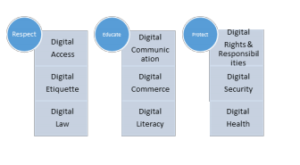The increase in use of technology in the last 10-20 years is scary to me because it can become an endless hole to many students with hardly any learning taking place. Within the digital age comes more platforms for cyber bullying, child kidnapping and identity theft, to name a few. Without any research being done, my first guess at defining digital citizenship was simply who you are online, meaning how you represent yourself and simply how you fit into the online community. Upon further research, I was not completely wrong, but I have just scratched the surface. Heick (2020) defines digital citizenship as “The quality of habits, actions, and consumption patterns that impact the ecology of digital content and communities.” At an early age students are taught to use computers as a part of elementary school, this included typing lesson and exploring how to use different programs while on a safe server to do so. When students get into high school, they have already established themselves in the digital world and sometimes without being taught how to stay safe while being a digital citizen. Zook (2019) points out that there is “a major difference between good digital citizenship and bad digital citizenship.” Good digital citizenship means that you are using digital tools to connect with others, create lasting relationships and empathize with each other. Bad citizenship is using internet in an unsafe way, either through cyberbullying or social media misuse. Digital literacy goes hand in hand with digital citizenship and even though digital literacy is a difficult concept to teach, it is important for students to learn it to become good digital citizens. My biggest constant worry regarding the growing digital age is child protection and how important it is to teach safe internet use at a young age. Cucukcu (2018) “emphasizes the requirement of teaching the digital citizenship at childhood ages and during primary education at schools” (P.2) and has highlighted three main themes to teach early learners about digital citizenship. The themes are Respect (Respect to yourself and others), Educate (Educate yourself and others), Protect (Protect yourself and others). Below is a photo of how the learning can be broken down further.

3 themes of educating digital citizenship
(Cucukcu, 2018, P.2)
This is by no means a concrete framework that needs to be followed but it is a helpful visual when lesson planning for a unit on digital citizenship. Digital citizenship is important because it is a part of everyone’s life, and it is essentially your online identity. It is important to learn about digital citizenship at an early age because the practice of digital wellness can start at an earlier age and realizing the negative affects of the digital world can save many students and youth from a lifetime of hardships. A few big ideas to go along with teaching digital citizenship are teaching students the importance of treating people, places and spaces with respect and to have empathy because this trait is important to how people speak to each other and act online. Now what? Even though I will be going into secondary school education where most students will be already established in having created their “digital citizenship or identity” it is not a wasted class to have a lesson on digital citizenship and to bring in some really important truths about the digital world because at the end of the day… it is a deep dark hole that can be a very scary place.
References:
ÇUBUKCU, A. (2018). Child Online Protection in the Context of Digital Citizenship Perception. International Journal of Information Security Science, 7(4), 179–184.
Heick, T. (2020, September 08). The Definition Of Digital Citizenship: The Future Of Learning. Retrieved December 01, 2020, from https://www.teachthought.com/the-future-of-learning/the-definition-of-digital-citzenship/
Zook, C. (2019, December 10). What Is Digital Citizenship & How Do You Teach It? Retrieved December 01, 2020, from https://www.aeseducation.com/blog/what-is-digital-citizenship